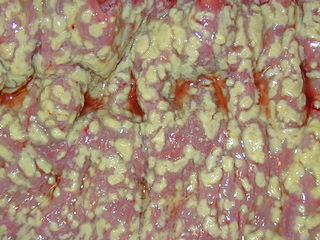Related Research Articles

Fusobacterium is a genus of obligate anaerobic, Gram-negative, non-sporeforming bacteria belonging to Gracilicutes. Individual cells are slender, rod-shaped bacilli with pointed ends. Fusobacterium was discovered in 1900 by Courmont and Cade and is common in the flora of humans.

Clostridium is a genus of anaerobic, Gram-positive bacteria. Species of Clostridium inhabit soils and the intestinal tract of animals, including humans. This genus includes several significant human pathogens, including the causative agents of botulism and tetanus. It also formerly included an important cause of diarrhea, Clostridioides difficile, which was reclassified into the Clostridioides genus in 2016.

Clostridioides difficile infection, also known as Clostridium difficile infection, is a symptomatic infection due to the spore-forming bacterium Clostridioides difficile. Symptoms include watery diarrhea, fever, nausea, and abdominal pain. It makes up about 20% of cases of antibiotic-associated diarrhea. Antibiotics can contribute to detrimental changes in gut microbiota; specifically, they decrease short-chain fatty acid absorption which results in osmotic, or watery, diarrhea. Complications may include pseudomembranous colitis, toxic megacolon, perforation of the colon, and sepsis.

The Clostridia are a highly polyphyletic class of Bacillota, including Clostridium and other similar genera. They are distinguished from the Bacilli by lacking aerobic respiration. They are obligate anaerobes and oxygen is toxic to them. Species of the class Clostridia are often but not always Gram-positive and have the ability to form spores. Studies show they are not a monophyletic group, and their relationships are not entirely certain. Currently, most are placed in a single order called Clostridiales, but this is not a natural group and is likely to be redefined in the future.

The Clostridiaceae are a family of the bacterial class Clostridia, and contain the genus Clostridium.
Enterocloster clostridioformis, formerly known as Clostridium clostridioforme, is an anaerobic, motile, Gram-positive bacterium.
Thermoanaerobacter is a genus in the phylum Bacillota (Bacteria). Members of this genus are thermophilic and anaerobic, several of them were previously described as Clostridium species and members of the now obsolete genera Acetogenium and Thermobacteroides
Thermoanaerobacter brockii, formerly Thermoanaerobium brockii, is a thermophilic, anaerobic, spore-forming bacterium.

Clostridioides difficile is a bacterium known for causing serious diarrheal infections, and may also cause colon cancer. It is known also as C. difficile, or C. diff, and is a Gram-positive species of spore-forming bacteria. Clostridioides spp. are anaerobic, motile bacteria, ubiquitous in nature and especially prevalent in soil. Its vegetative cells are rod-shaped, pleomorphic, and occur in pairs or short chains. Under the microscope, they appear as long, irregular cells with a bulge at their terminal ends. Under Gram staining, C. difficile cells are Gram-positive and show optimum growth on blood agar at human body temperatures in the absence of oxygen. C. difficile is catalase- and superoxide dismutase-negative, and produces up to three types of toxins: enterotoxin A, cytotoxin B and Clostridioides difficile transferase. Under stress conditions, the bacteria produce spores that are able to tolerate extreme conditions that the active bacteria cannot tolerate.
Clostridium scindens is a species of bacteria in the genus Clostridium that are found in the human gut.
Butyricicoccus is a bacterial genus from the family of Oscillospiraceae., formerly ranked in the family of Clostridiaceae.
Enterocloster aldensis, formerly Clostridium aldenense, is a bacterium in the genus Enterocloster. The type species was isolated from clinical infections in California in the United States along E. citroniae and placed in the genus Clostridium. Together with other gram-negative species, it was moved to the new genus Enterocloster in 2020. The name pertains to R. M. Alden Research Laboratory and its first patron, Rose M. Alden Goldstein.
Faecalicatena is a bacterial genus from the family of Lachnospiraceae.
Oscillospiraceae is a family of bacteria in the class Clostridia. All Oscillospiraceae are obligate anaerobes. However, members of the family have diverse shapes, with some rod-shaped and others cocci.
Absiella is a genus from the family of Erysipelotrichaceae.

Clostridioides is a genus of Gram-positive bacteria, which includes Clostridioides difficile, a human pathogen causing an infectious diarrhea.
Sarcina ventriculi is a bacterial species in the Clostridiaceae family. Phylogenetics have placed S. ventriculi and Sarcina maxima within the genus Clostridium. It has been proposed to be renamed to Clostridium ventriculi in 2016, but ultimately retained its name due to the genus name of Sarcina taking priority over Clostridium.
Maledivibacter is a bacterial genus from the family of Clostridiaceae with one known species. Clostridium halophilum has been reclassified to Maledivibacter halophilus.
Enterocloster is a genus of anaerobic bacteria. Species in Enterocloster were historically ordered in the genera Lachnoclostridium or Clostridium before advances in phylogenetics supported formation of a new genus.
Flavonifractor plautii is a bacterium of the monotypic genus Flavonifractor in the family Oscillospiraceae.
References
- ↑ Page Genus: Clostridium on "LPSN - List of Prokaryotic names with Standing in Nomenclature". Deutsche Sammlung von Mikroorganismen und Zellkulturen . Retrieved 2022-10-03.
- 1 2 3 4 5 6 7 8 9 10 11 12 13 Parte AC. "Clostridium". LPSN .
- ↑ Haas, Kelly N.; Blanchard, Jeffrey L. (2020). "Reclassification of the Clostridium clostridioforme and Clostridium sphenoides clades As enterocloster gen. nov. And lacrimispora gen. nov., including reclassification of 15 taxa". International Journal of Systematic and Evolutionary Microbiology. 70 (1): 23–34. doi: 10.1099/ijsem.0.003698 . PMID 31782700. S2CID 208358321.
- ↑ Lawson, Paul A.; Citron, Diane M.; Tyrrell, Kerin L.; Finegold, Sydney M. (August 2016). "Reclassification of Clostridium difficile as Clostridioides difficile (Hall and O'Toole 1935) Prévot 1938". Anaerobe. 40: 95–99. doi:10.1016/j.anaerobe.2016.06.008. PMID 27370902.